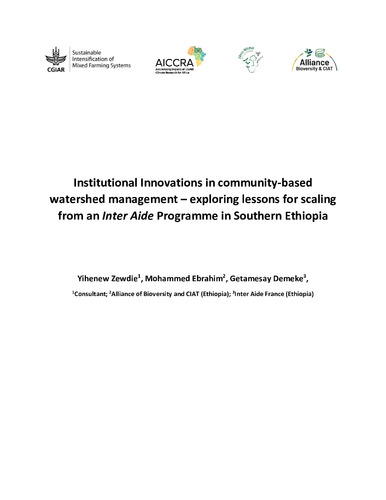Institutional innovations in community-based watershed management – exploring lessons for scaling from an Inter Aide Programme in Southern Ethiopia
This is a qualitative study on institutional innovations that the Inter Aide France (IAF) project has pioneered as part of its people-centred land management activities in Hadiya and Kembata-Tembaro (HKT) zones of Southern Nations, Nationalities, and Peoples Region of Ethiopia. This is an offshoot of an ongoing partnership between IAF and the Alliance of Bioversity International and CIAT. The specific objectives of the study were to: document working practices and approaches that AIF has been pursuing as integral components of its watershed development thrust; synthesise key achievements and emerging outcomes; and identify key lessons learnt for scaling and systematically integrating innovative practices and working modalities into regular government operations.
The study analysed documents on project progress and achievements; it employed field observations and key informant interview techniques involving local community leaders from two woredas (districts) of HKT zones and senior natural resource management experts at woreda and zonal levels to understand working modalities of the project and local views and experiences with project implementation. Through providing a tour of the horizon of public sector financed community-based watershed management interventions in the two zones, the study highlighted the shortcomings of these interventions in the areas of planning and implementation rigour. The present study has also indicated the factors that set apart the IAF-supported project from its predecessors in terms of the extension approach it followed and the technical sequencing of the package of interventions recommended for implementation.
IAF has put in place a team of professional staff at local levels to provide technical leadership to the myriad activities under its agricultural development component. At the same time, IAF has exerted substantial effort to integrate the activities of its own staff into the regular operations of the respective administrative organs and departments of agriculture. This has been pursued in an institutionalised manner. The establishment of steering committees at regional, zonal and woreda levels, with the explicit purpose of involving key stakeholders in the planning, implementation, learning and monitoring of the interventions is the key vehicle through which IAF strives to embed its technical interventions into regular government operations. Through facilitating the establishment of Kebele Watershed Task Forces representatives of government representatives and leaders of both local formal organisations and traditional structures (notably, Iddirs), the project approach was adjudged to be a worthwhile one that has helped mobilise local technical and organisational resources for effective programme implementation and has gone a long way towards empowering local communities to decide on local affairs of environmental conservation and agricultural development on their own.
Categorised under batches ranging from one to four, IAF has been pursuing a spatially differentiated approach in its interventions across the two zones. Communities and watersheds that were embraced at the beginning of the present project are known as Batch One (since 2019/2020), whilst those characterised as Batches Two to Four refer to sites that the project embraced in subsequent years. Batch differentiation is meant to reflect the sequences followed in the technical interventions made in the field. The project planning process is governed by the global project intervention approach that recognises three major components that are to be implemented sequentially: (a) ensure easy access to grass (for biological SWC measures); (b) implement SWC interventions; and (c) pursue eco-friendly agricultural diversification.
The present project has built on IAF’s several years of programme implementation experience in participatory watershed management and livelihood diversification in southern Ethiopia. Pursuing a purpose-tailored and well-timed technical and organisational training at different levels, using carefully selected and sufficiently motivated farmer technical leaders (commonly known as Peer Educators), putting premium on technical excellence and well-timed sequencing of interventions, and employing a planning-in-action approach to inform the type and pace of implementation of interventions, the project has helped register the following major watershed development benefits: (i) facilitated access for farming families to fodder grasses; (ii) engendered effective soil and water conservation through the establishment of erosion control structures and appropriate management of these structures at the level of entire watersheds; (iii) promoted agroforestry through a decentralised system of nursery operation and dissemination of planting materials; (iv) strengthened on-farm crop diversification, including adding value to the local livestock economy; and (v) enabled direct project beneficiaries to generate higher household disposable income.
In addition to the intrinsic significance of the IAF-supported project to the target communities, the project has engendered several feasible and replicable approaches and working practices that also have instrumental significance that can be scaled taking due consideration of local realities. In this later respect, the major scalable innovations include recruitment and use of well-motivated and technically capable Peer Educators; workable sequencing of soil and water conservation interventions; identification of entry points for setting in motion crop and livelihood diversification; pursuing an approach to local technical and organisational capacity building rooted in community practices; and establishment of a bottom-up monitoring, learning and accountability system amenable for digitising.
The study, however, has noted that scaling should not be thought of as an automatic process but rather a task that should be approached in an organised manner, as a work stream on its own in zonal and regional departments of agriculture. In addition, thought should be given to embedding some of the project experiences within the training curricula of Development Agents and other subject-matter specialists as well as in Agri-TVET institutions in the region.
It is worth noting that the project is mid-way through its implementation phase; hence, more and/or better institutional innovations are likely to be co-created in the remaining life span of the project. Thus, this document should be considered as a living document, that needs to be updated and edited as necessary whilst, at the same time, taking to heart some of the more feasible recommendations made in this piece and those to come in each subsequent iteration.

